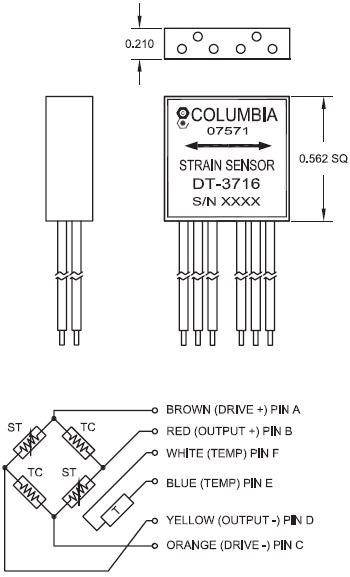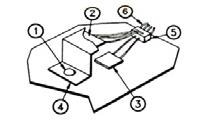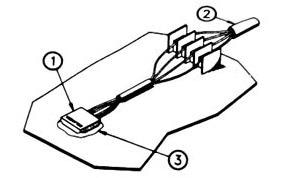Columbia Series DT3716 sensors are developed to precisely monitor both strain and temperature on straight mounting surfaces. These sensors have a DIN standard 1000 Ω platinum RTD that delivers precise temperature measurements at the exact site of sensor attachment, in addition to the precision, robustness and easy installation of the flight-qualified Series DTD2684 sensors.
Similar sensors have been used to monitor possible fatigue damage on aircraft that have logged thousands of hours in the air, as well as high-stress maneuvers and landings. These sensors are also appropriate for normal laboratory applications due to their simplicity and dependability.
When applied to a range of surface materials, the Series DT3716 sensors allow automated temperature compensation of strain outputs. Models are provided as compensation for commonly used materials used in aircraft structural manufacturing, as well as alternative materials as mentioned.
The sensors include Teflon-insulated lead wires with a gauge of 26 AWG to make electrical connections easier. The Columbia Model 5802 Strain Gage Amplifier may additionally power and signal condition the sensors’ strain and temperature outputs.
Note: Exports from the United States are subject to the Export Administration Regulations (EAR) and/or the International Traffic in Arms Regulations (ITAR) authorization procedures.
- Straight Surface Mounting
- Self-Temperature Compensating
- Strain and Temperature Outputs
Specifications
Operational
Table 1. Source: Columbia Research Laboratories, Inc.
| Operational 1 |
Series DT3716 |
| Input Resistance |
1000 Ω, ±2% |
| Output Resistance |
1000 Ω, ±2% |
| Sensitivity |
1,025 (±1 %) mV/V/1000 μϵ |
| Rated Excitation Voltage |
10.0 VDC |
| Linearity |
±0.5% Max. |
| Zero Strain Offset |
±0.5 mV/V Typ. |
| Operating Range |
-3500 to +5000 μϵ |
| Sensitivity Shift |
±0.005% / °F |
| Hysteresis, Repeatability |
±0.013% Max. |
| Zero Shift |
±0.00025 mV/V/°F Typ. |
| Creep |
<0.5%, 5 Min. @ 5000 μϵ |
| Temperature Sensor |
Platinum RTD, 1000 Ω @ 0 °C DIN EN 60751, Class 2B (0.3 mA Max. Current) |
Environmental
Table 2. Source: Columbia Research Laboratories, Inc.
| Environmental 2 |
Series DT3716 |
| Temperature Range |
-54° to +125 °C |
| Vibration |
30 g, 10 Hz to 2 KHz |
| Humidity |
MIL-STD-202 Method 103B |
| Salt Spray |
MIL-STD-202 Method 101D (168 Hours) |
| Insulation Resistance |
100 Meg. min @ 500 VDC |
| Dielectric Strength |
1050 VRMS, 60 Hz, 1 Min. |
| Altitude |
Sea Level to 70,000 Ft. |
| Shock |
100 g, 11 mSec |
| Flammability |
MIL-STD-202 Method 111A |
| Fluids |
Resistance to short term exposure to fuel, lubricating oils and hydraulic fluids |
Physical
Table 3. Source: Columbia Research Laboratories, Inc.
| Physical |
Series DT3716 |
| Size |
0.562" x 0.562” x 0.210” Thk |
| Encapsulation |
Silicone Rubber per MIL-S-23586A Type I, Class 2, Grade A |
| Weight |
Approx. 15 gms (Depending on radius selected) |
| Matrix |
0.001" Polyimide |
| Leads |
#26AWG, Teflon Ins, SPC, 24" Nom. |
1 @25 °C. 2 Installed Gage
Schematic Diagram

Image Credit: Columbia Research Laboratories, Inc.

Typical Installation of Old Style Strain Gages. 1. Bolt or rivet removed from assembly; 2. Dummy gage(s) bonded to “Z Tab” of same material as structure; 3. Active gage bonded to structure under test; 4. “Z Tab” mounted to structure with bond or rivet; 5. Strain gage leads interwired and soldered to junction block; and 6. Entire unit covered with protective material. Image Credit: Columbia Research Laboratories, Inc.

Installation of Columbia Strain Sensor. 1. Strain Sensor bonded to surface under test; 2. Leads connected to wire harness; and 3. Coat sensor and wires with waterproofing material. Image Credit: Columbia Research Laboratories, Inc.
Ordering Information
Table 4. Source: Columbia Research Laboratories, Inc.
| Model |
Lead Length |
Compensating Material |
| DT3716-1 |
24" |
Aluminum 7075-T6 or 7050-T73651, IVD |
| DT3716-2 |
24" |
Steel, AISI 4130 or HP9-4-.20 |
| DT3716-3 |
24" |
Titanium TI-6AL-4V Annealed |
| DT3716-4 |
24" |
Carbon/Epoxy MMS 549 Type 1 |
Advantages
- Twice as much output
- A higher level of precision
- No compromise on structural integrity
- Installation time is reduced
- Optimal temperature compensation